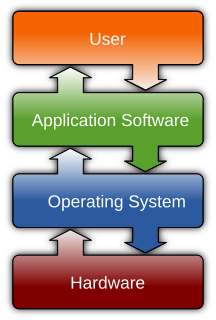
Seymour Roger Cray was an American electrical engineer and supercomputer architect who designed a series of computers that were the fastest in the world for decades, and founded Cray Research which built many of these machines. Called "the father of supercomputing", Cray has been credited with creating the supercomputer industry. Joel S. Birnbaum, then chief technology officer of Hewlett-Packard, said of him: "It seems impossible to exaggerate the effect he had on the industry; many of the things that high performance computers now do routinely were at the farthest edge of credibility when Seymour envisioned them." Larry Smarr, then director of the National Center for Supercomputing Applications at the University of Illinois and a physicist, linking him: "He [Seymour Cray] is the Thomas Edison of the supercomputing industry."
In computing, time-sharing is the sharing of a computing resource among many users by means of multiprogramming and multi-tasking at the same time.

Control Data Corporation (CDC) was a mainframe and supercomputer firm. CDC was one of the nine major United States computer companies through most of the 1960s; the others were IBM, Burroughs Corporation, DEC, NCR, General Electric, Honeywell, RCA, and UNIVAC. CDC was well-known and highly regarded throughout the industry at the time. For most of the 1960s, Seymour Cray worked at CDC and developed a series of machines that were the fastest computers in the world by far, until Cray left the company to found Cray Research (CRI) in the 1970s. After several years of losses in the early 1980s, in 1988 CDC started to leave the computer manufacturing business and sell the related parts of the company, a process that was completed in 1992 with the creation of Control Data Systems, Inc. The remaining businesses of CDC currently operate as Ceridian.
Project Genie was a computer research project started in 1964 at the University of California, Berkeley.
It produced an early time-sharing system including the Berkeley Timesharing System, which was then commercialized as the SDS 940.
The ETA10 is a line of vector supercomputers designed, manufactured, and marketed by ETA Systems, a spin-off division of Control Data Corporation (CDC). The ETA10 was announced in 1986, with the first deliveries made in early 1987. The system was an evolution of the CDC Cyber 205, which can trace its origins back to the CDC STAR-100.

The CDC 7600 was the Seymour Cray-designed successor to the CDC 6600, extending Control Data's dominance of the supercomputer field into the 1970s. The 7600 ran at 36.4 MHz and had a 65 Kword primary memory using magnetic core and variable-size secondary memory. It was generally about ten times as fast as the CDC 6600 and could deliver about 10 MFLOPS on hand-compiled code, with a peak of 36 MFLOPS. In addition, in benchmark tests in early 1970 it was shown to be slightly faster than its IBM rival, the IBM System/360, Model 195. When the system was released in 1969, it sold for around $5 million in base configurations, and considerably more as options and features were added.
The CDC Cyber range of mainframe-class supercomputers were the primary products of Control Data Corporation (CDC) during the 1970s and 1980s. In their day, they were the computer architecture of choice for scientific and mathematically intensive computing. They were used for modeling fluid flow, material science stress analysis, electrochemical machining analysis, probabilistic analysis, energy and academic computing, radiation shielding modeling, and other applications. The lineup also included the Cyber 18 and Cyber 1000 minicomputers. Like their predecessor, the CDC 6600, they were unusual in using the ones' complement binary representation.

The CDC 8600 was the last of Seymour Cray's supercomputer designs while he worked for Control Data Corporation. As the natural successor to the CDC 6600 and CDC 7600, the 8600 was intended to be about 10 times as fast as the 7600, already the fastest computer on the market. The design was essentially four 7600's, packed into a very small chassis so they could run at higher clock speeds.

PLATO was the first generalized computer-assisted instruction system. Starting in 1960, it ran on the University of Illinois' ILLIAC I computer. By the late 1970s, it supported several thousand graphics terminals distributed worldwide, running on nearly a dozen different networked mainframe computers. Many modern concepts in multi-user computing were originally developed on PLATO, including forums, message boards, online testing, e-mail, chat rooms, picture languages, instant messaging, remote screen sharing, and multiplayer video games.
Tymshare, Inc. was a time-sharing service and third-party hardware maintenance company competing with companies such as Four-Phase Systems, CompuServe, and Digital Equipment Corporation. Tymshare developed or acquired innovative technologies, including data networking (Tymnet), electronic data interchange (EDI), credit card and payment processing, telecommunications provisioning (COEES), office automation and database technology (Magnum). It was headquartered in Cupertino, California from 1964 to 1984.
The THE multiprogramming system or THE OS was a computer operating system designed by a team led by Edsger W. Dijkstra, described in monographs in 1965-66 and published in 1968.
Dijkstra never named the system; "THE" is simply the abbreviation of "Technische Hogeschool Eindhoven", then the name of the Eindhoven University of Technology of the Netherlands. The THE system was primarily a batch system that supported multitasking; it was not designed as a multi-user operating system. It was much like the SDS 940, but "the set of processes in the THE system was static".
The SDS 940 was Scientific Data Systems' (SDS) first machine designed to directly support time-sharing. The 940 was based on the SDS 930's 24-bit CPU, with additional circuitry to provide protected memory and virtual memory.

The CDC 6000 series was a family of mainframe computers manufactured by Control Data Corporation in the 1960s. It consisted of the CDC 6200, CDC 6300, CDC 6400, CDC 6500, CDC 6600 and CDC 6700 computers, which were all extremely rapid and efficient for their time. Each was a large, solid-state, general-purpose, digital computer that performed scientific and business data processing as well as multiprogramming, multiprocessing, Remote Job Entry, time-sharing, and data management tasks under the control of the operating system called SCOPE. By 1970 there also was a time-sharing oriented operating system named KRONOS. They were part of the first generation of supercomputers. The 6600 was the Flagship of Control Data's 6000 series.

Community Memory (CM) was the first public computerized bulletin board system. Established in 1973 in Berkeley, California, it used an SDS 940 timesharing system in San Francisco connected via a 110 baud link to a teleprinter at a record store in Berkeley to let users enter and retrieve messages. Individuals could place messages in the computer and then look through the memory for a specific notice.

The SDS 930 is a commercial 24-bit computer using bipolar junction transistors sold by Scientific Data Systems.
It was announced in December 1963, with first installations in June 1964.
Service in Informatics and Analysis was one of the pioneering time-sharing service bureau companies in the late 1960s, later known as SIA Computer Services. Its head office was located at Lower Belgrave Street, close to Victoria Station in London, and the company had branch offices in Edinburgh, Manchester, the West End, Paris and in Hong Kong. SIA offered terminal services via the Post Office telephone network at speeds of 10, 15, 30, 60 and 120 characters per second for Teletype-style terminals and of 1200 baud, 2400 baud and 4800 baud for Remote Job Entry terminals. Later with the release of the IBM PC, systems were developed to emulate the Remote Batch and interactive terminals.
Clients could also visit the head or branch offices to submit their jobs personally or have them accepted and supervised by the production department.

The kernel is a computer program that is the core of a computer's operating system, with complete control over everything in the system. On most systems, it is one of the first programs loaded on start-up. It handles the rest of start-up as well as input/output requests from software, translating them into data-processing instructions for the central processing unit. It handles memory and peripherals like keyboards, monitors, printers, and speakers.

The ICL 7500 series was a range of terminals and workstations, that were developed by ICL during the 1970s for their new range ICL 2900 Series mainframe computers. The colour scheme was compatible with the 2900. The term 7561 is a commonly used though loose term for the interactive video aspects of the 7502 series. The 7501 and 7502 systems were known as Modular Terminal Processors in marketing publications. 7501 and 7502 systems were built at Blackhorse Road, Letchworth.

In an asymmetric multiprocessing system (AMP), not all CPUs are treated equally; for example, a system might allow only one CPU to execute operating system code or might allow only one CPU to perform I/O operations. Other AMP systems would allow any CPU to execute operating system code and perform I/O operations, so that they were symmetric with regard to processor roles, but attached some or all peripherals to particular CPUs, so that they were asymmetric with respect to the peripheral attachment. Asymmetric multiprocessing was the only method for handling multiple CPUs before symmetric multiprocessing (SMP) was available. It has also been used to provide less expensive options on systems where SMP was available. Additionally, AMP is used in applications that are dedicated, such as embedded systems, when individual processors can be dedicated to specific tasks at design time.















